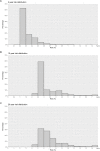Developing and validating an individualized breast cancer risk prediction model for women attending breast cancer screening
- PMID: 33755692
- PMCID: PMC7987139
- DOI: 10.1371/journal.pone.0248930
Developing and validating an individualized breast cancer risk prediction model for women attending breast cancer screening
Abstract
Background: Several studies have proposed personalized strategies based on women's individual breast cancer risk to improve the effectiveness of breast cancer screening. We designed and internally validated an individualized risk prediction model for women eligible for mammography screening.
Methods: Retrospective cohort study of 121,969 women aged 50 to 69 years, screened at the long-standing population-based screening program in Spain between 1995 and 2015 and followed up until 2017. We used partly conditional Cox proportional hazards regression to estimate the adjusted hazard ratios (aHR) and individual risks for age, family history of breast cancer, previous benign breast disease, and previous mammographic features. We internally validated our model with the expected-to-observed ratio and the area under the receiver operating characteristic curve.
Results: During a mean follow-up of 7.5 years, 2,058 women were diagnosed with breast cancer. All three risk factors were strongly associated with breast cancer risk, with the highest risk being found among women with family history of breast cancer (aHR: 1.67), a proliferative benign breast disease (aHR: 3.02) and previous calcifications (aHR: 2.52). The model was well calibrated overall (expected-to-observed ratio ranging from 0.99 at 2 years to 1.02 at 20 years) but slightly overestimated the risk in women with proliferative benign breast disease. The area under the receiver operating characteristic curve ranged from 58.7% to 64.7%, depending of the time horizon selected.
Conclusions: We developed a risk prediction model to estimate the short- and long-term risk of breast cancer in women eligible for mammography screening using information routinely reported at screening participation. The model could help to guiding individualized screening strategies aimed at improving the risk-benefit balance of mammography screening programs.
Conflict of interest statement
The authors have declared that no competing interests exist.
Figures
Similar articles
-
Breast Density and Benign Breast Disease: Risk Assessment to Identify Women at High Risk of Breast Cancer.J Clin Oncol. 2015 Oct 1;33(28):3137-43. doi: 10.1200/JCO.2015.60.8869. Epub 2015 Aug 17. J Clin Oncol. 2015. PMID: 26282663 Free PMC article.
-
Differences in breast cancer risk after benign breast disease by type of screening diagnosis.Breast. 2020 Dec;54:343-348. doi: 10.1016/j.breast.2020.09.005. Epub 2020 Oct 3. Breast. 2020. PMID: 33023825 Free PMC article.
-
Mammographic features of benign breast lesions and risk of subsequent breast cancer in women attending breast cancer screening.Eur Radiol. 2022 Jan;32(1):621-629. doi: 10.1007/s00330-021-08118-y. Epub 2021 Jun 22. Eur Radiol. 2022. PMID: 34156554
-
Assessing Risk of Breast Cancer: A Review of Risk Prediction Models.J Breast Imaging. 2021 Feb 19;3(2):144-155. doi: 10.1093/jbi/wbab001. eCollection 2021 Mar-Apr. J Breast Imaging. 2021. PMID: 33778488 Free PMC article. Review.
-
[Breast cancer under control - risk calculators].Med Pr. 2024 Dec 23;75(6):531-544. doi: 10.13075/mp.5893.01553. Epub 2024 Dec 18. Med Pr. 2024. PMID: 39692040 Review. Polish.
Cited by
-
Family history of breast cancer, mammographic breast density and breast cancer risk: Findings from a cohort study of Korean women.Breast. 2022 Oct;65:180-186. doi: 10.1016/j.breast.2022.08.008. Epub 2022 Aug 23. Breast. 2022. PMID: 36049384 Free PMC article.
-
Alcohol consumption and breast lesions: targets for risk-based screening in high-risk Italian women.Breast Cancer. 2025 May 16. doi: 10.1007/s12282-025-01720-8. Online ahead of print. Breast Cancer. 2025. PMID: 40380018
-
Mammographic calcifications association with risk of advanced breast cancer.Breast Cancer Res Treat. 2025 Aug;212(3):555-567. doi: 10.1007/s10549-025-07753-z. Epub 2025 Jun 17. Breast Cancer Res Treat. 2025. PMID: 40526234 Free PMC article.
-
Development and performance of female breast cancer incidence risk prediction models: a systematic review and meta-analysis.Ann Med. 2025 Dec;57(1):2534522. doi: 10.1080/07853890.2025.2534522. Epub 2025 Jul 20. Ann Med. 2025. PMID: 40684451 Free PMC article.
-
Optimizing breast cancer screening strategies for women with different BMI levels in Ghana: A simulation-based study on BMI-dependent tumor growth model.PLOS Glob Public Health. 2025 Jul 28;5(7):e0004953. doi: 10.1371/journal.pgph.0004953. eCollection 2025. PLOS Glob Public Health. 2025. PMID: 40720523 Free PMC article.
References
-
- Onega T, Beaber EF, Sprague BL, Barlow WE, Haas JS, Tosteson AN, et al.. Breast cancer screening in an era of personalized regimens: a conceptual model and National Cancer Institute initiative for risk-based and preference-based approaches at a population level. Cancer. 2014;120(19):2955–64. 10.1002/cncr.28771 - DOI - PMC - PubMed
Publication types
MeSH terms
LinkOut - more resources
Full Text Sources
Other Literature Sources
Medical


